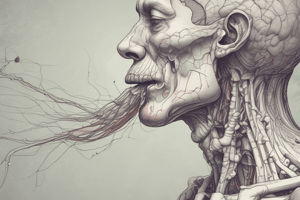Podcast
Questions and Answers
What is the primary purpose of the 3 oz Water Swallow Test?
What is the primary purpose of the 3 oz Water Swallow Test?
- Evaluate aspiration severity during FEES.
- Diagnose swallowing disorders without observation.
- Measure vocal quality before and after swallowing.
- Assess swallowing safety by having patients drink 3 ounces of water. (correct)
Which of the following represents a true negative result in the context of the 3 oz Water Swallow Test?
Which of the following represents a true negative result in the context of the 3 oz Water Swallow Test?
- Coughing noted during the test.
- Aspiration observed in FEES after failing the test.
- No aspiration in FEES after passing the test. (correct)
- Wet vocal quality detected after the test.
What percentage of patients who aspirated on FEES are likely to fail the 3 oz Water Swallow Test?
What percentage of patients who aspirated on FEES are likely to fail the 3 oz Water Swallow Test?
- 96% (correct)
- 75%
- 98%
- 50%
What implication does a high negative predictive value of 98% suggest about passing the 3 oz test?
What implication does a high negative predictive value of 98% suggest about passing the 3 oz test?
What challenge exists regarding the specificity of the 3 oz Water Swallow Test?
What challenge exists regarding the specificity of the 3 oz Water Swallow Test?
What criterion indicates a need for referral based on the 3 oz Water Swallow Test results?
What criterion indicates a need for referral based on the 3 oz Water Swallow Test results?
Which result of the 3 oz Water Swallow Test represents a false positive?
Which result of the 3 oz Water Swallow Test represents a false positive?
What does a high sensitivity of 96% indicate regarding the 3 oz Water Swallow Test?
What does a high sensitivity of 96% indicate regarding the 3 oz Water Swallow Test?
What is a significant limitation of the 3 oz Water Swallow Test regarding specificity?
What is a significant limitation of the 3 oz Water Swallow Test regarding specificity?
How can passing the 3 oz Water Swallow Test be interpreted regarding thin liquids?
How can passing the 3 oz Water Swallow Test be interpreted regarding thin liquids?
Which aspect of the 3 oz Water Swallow Test interpretation helps in predicting aspiration risk?
Which aspect of the 3 oz Water Swallow Test interpretation helps in predicting aspiration risk?
Which observation during the test would classify as a true positive result?
Which observation during the test would classify as a true positive result?
Flashcards
3 oz Water Swallow Test Purpose
3 oz Water Swallow Test Purpose
Assesses swallowing safety by having patients drink 3 ounces of water without interruption.
3 oz Water Swallow Test Referral Criteria
3 oz Water Swallow Test Referral Criteria
Inability to complete the test, coughing/choking during, or wet/hoarse voice within 1 minute after.
True Positive (3 oz test)
True Positive (3 oz test)
Aspiration observed (FEES) after failing the 3 oz water swallow test.
High Sensitivity (3 oz test)
High Sensitivity (3 oz test)
Signup and view all the flashcards
Low Specificity (3 oz test)
Low Specificity (3 oz test)
Signup and view all the flashcards
3 oz Water Swallow Test
3 oz Water Swallow Test
Signup and view all the flashcards
Referral Criteria
Referral Criteria
Signup and view all the flashcards
True Negative
True Negative
Signup and view all the flashcards
False Positive
False Positive
Signup and view all the flashcards
High Sensitivity
High Sensitivity
Signup and view all the flashcards
High Negative Predictive Value
High Negative Predictive Value
Signup and view all the flashcards
Low Specificity
Low Specificity
Signup and view all the flashcards
Study Notes
3 oz Water Swallow Test
-
Purpose: Evaluates swallowing safety by having patients drink 3 ounces of water uninterrupted.
-
Referral Criteria:
- Inability to complete the task
- Coughing or choking during the test
- Wet or hoarse vocal quality during or within one minute after the test.
Result Interpretations
-
True Positive: Aspiration observed during FEES after failing the test.
-
True Negative: No aspiration observed during FEES after passing the test (indicates no swallowing problem).
-
False Positive: No aspiration observed during FEES despite failing the test.
-
False Negative: Aspiration observed during FEES after passing the test.
Key Points for Interpretation
-
High Sensitivity: 96% of patients who aspirated on FEES failed the 3-ounce test.
-
High Negative Predictive Value: 98% of those who passed the test did not aspirate on FEES. This means if the test is passed, it's highly likely no aspiration occurred.
-
Passing the test: Passing the 3-ounce water test suggests safe tolerance of thin liquids.
-
Low Specificity: 50% specificity for detecting aspiration during FEES. This means many who fail the test might not aspirate during FEES (high false positive rate).
Studying That Suits You
Use AI to generate personalized quizzes and flashcards to suit your learning preferences.
Description
This quiz evaluates the 3 oz Water Swallow Test, which assesses swallowing safety by determining the patient's ability to drink water without issue. Learn about the referral criteria, result interpretations, and key points for accurate assessment. Perfect for healthcare professionals involved in swallowing evaluations.



